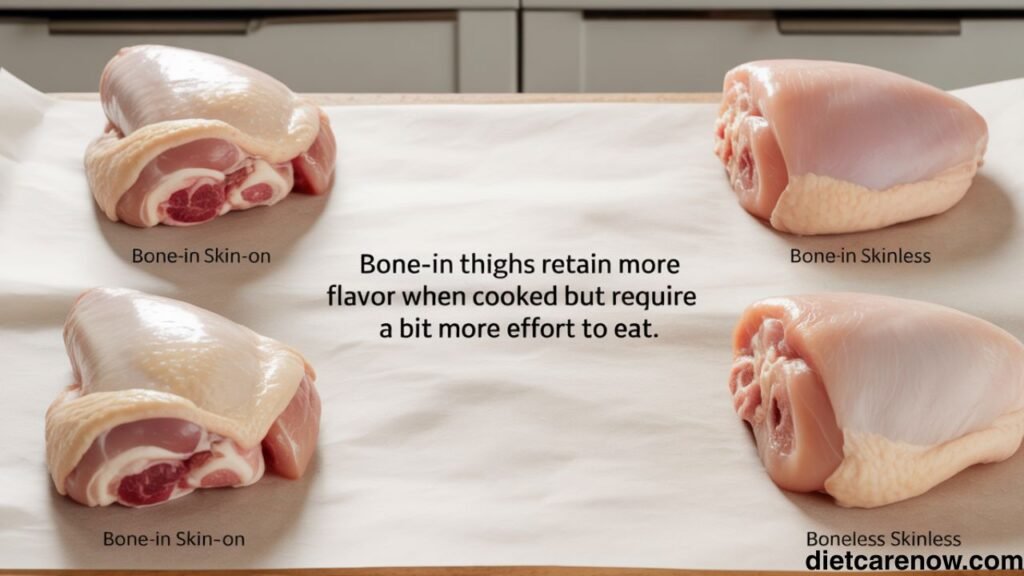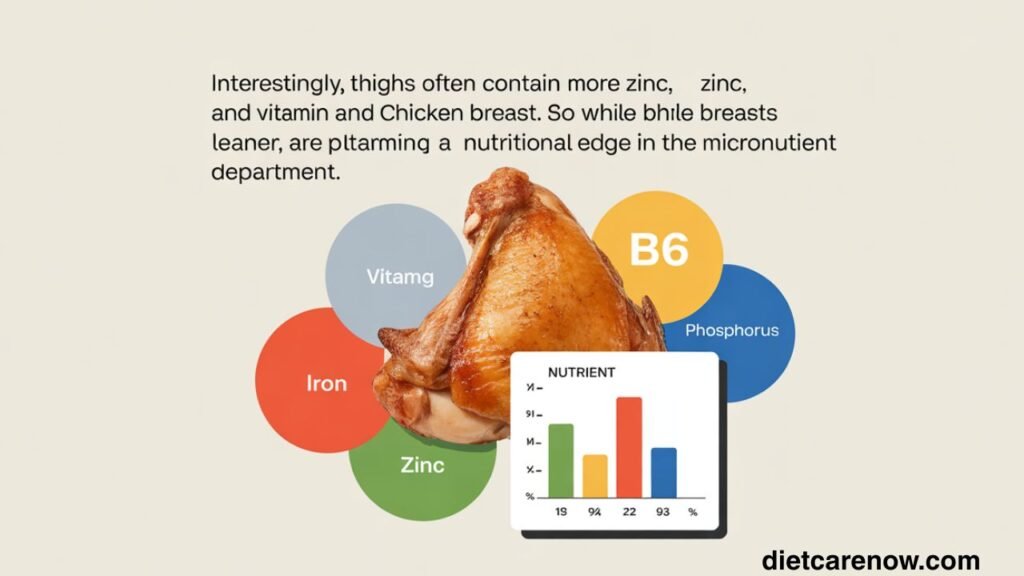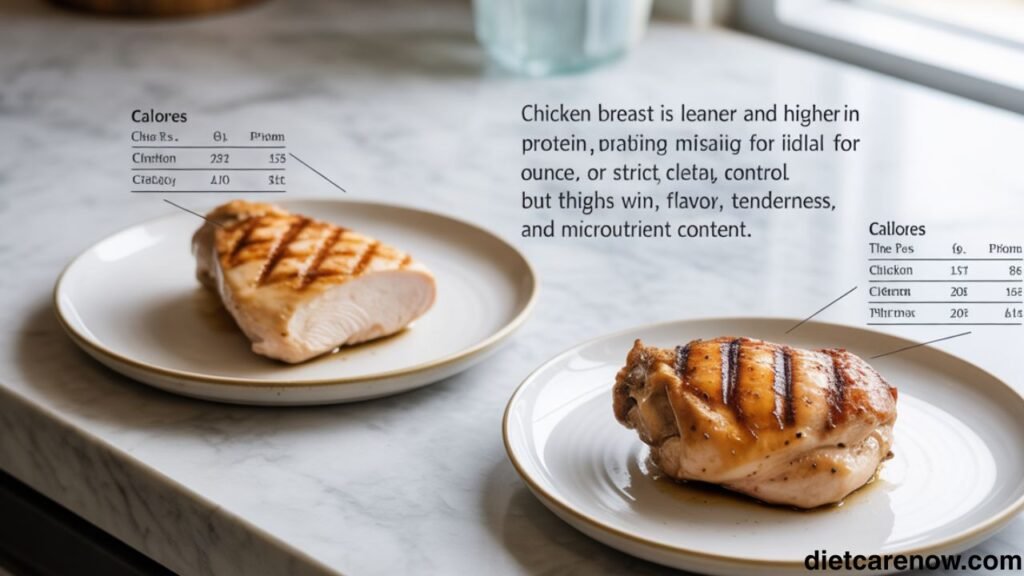Chicken thighs are one of the most versatile and flavorful cuts of poultry. Whether you grill, roast, or slow-cook them, they always deliver a juicy, rich taste that chicken breasts often can’t match. But flavor isn’t the only thing that makes them popular—many people are also curious about their nutritional value, especially per ounce.
When tracking calories, protein, or fat, measuring food by the ounce gives you an accurate view of what you’re eating. That’s why “chicken thigh nutrition per ounce” is such a common search. Understanding how much protein, fat, and other nutrients you get in a single ounce helps with portion control, meal prep, and meeting fitness or weight goals.
Compared to other parts of the chicken—like lean breasts, crispy wings, or meaty drumsticks—thighs strike a great balance between flavor and nutrition. They’re slightly higher in fat than breasts but offer more tenderness and taste, making them a favorite for both home cooks and athletes alike.
Chicken Thigh Basics: What Makes Them Unique
Chicken thighs come from the upper part of the bird’s leg, right above the drumstick. They’re available in several forms: bone-in or boneless, skin-on or skinless. Each type has its own texture, flavor, and nutritional differences.
- Bone-in thighs retain more flavor when cooked but require a bit more effort to eat.
- Boneless thighs are convenient and cook faster.
- Skin-on thighs have that extra layer of crispiness and taste, but they also add calories and fat.
- Skinless thighs are leaner and often preferred for calorie-controlled diets.
Thigh meat is darker than breast meat because it contains more myoglobin—a protein that helps transport oxygen in the muscles. This difference gives thighs their signature juicy texture and deeper flavor.
Also read: /cell-nutrition/

Nutritional Overview per Ounce of Chicken Thigh
Let’s get to the numbers. On average, one ounce (28 grams) of cooked, skinless chicken thigh provides approximately:
| Nutrient | Amount per 1 oz (Cooked, Skinless) |
|---|---|
| Calories | 55 kcal |
| Protein | 7.2 g |
| Total Fat | 2.7 g |
| Saturated Fat | 0.8 g |
| Cholesterol | 23 mg |
| Sodium | 25 mg |
| Iron | 0.3 mg |
| Zinc | 0.4 mg |
Raw chicken thighs will show slightly different numbers since cooking reduces water content and increases nutrient density per ounce.
The method of cooking—whether you grill, bake, fry, or boil—also affects these values. Frying adds fat, while boiling or grilling without oil keeps it leaner.
Protein Content: The Building Block of Chicken Thighs
Protein is what most people look for first when checking chicken nutrition. In just one ounce of cooked, skinless chicken thigh, you get about 7 grams of protein.
That’s slightly less than chicken breast, which offers around 8–9 grams per ounce, but thighs still provide a strong protein punch. Plus, the extra fat in thighs helps keep you full longer and adds flavor, making it easier to enjoy your meals without feeling deprived.
Protein is essential for muscle growth, tissue repair, and immune health. For athletes or anyone aiming to maintain lean mass, chicken thighs are a reliable and satisfying protein source.
Fat and Calories in Chicken Thighs
Fat gives chicken thighs their signature richness. Per ounce, skinless thighs contain around 2.7 grams of fat, while skin-on versions can have up to 5 grams.
Here’s the breakdown:
- Saturated Fat: ~0.8 g (small amount)
- Monounsaturated and Polyunsaturated Fats: ~1.9 g (the healthier fats)
The fat in chicken thighs isn’t all “bad.” In fact, moderate amounts of these healthy fats support hormone function and nutrient absorption.
Calorie-wise, skinless thighs average 55 calories per ounce, while skin-on thighs can rise to about 70–75 calories per ounce. The difference mainly comes from the added fat in the skin.
Myth alert: many people assume chicken thighs are “unhealthy” because they have more fat than breasts. But most of that fat is unsaturated, and when eaten in moderation, it’s perfectly fine for a balanced diet.
Vitamins and Minerals in Chicken Thighs
Chicken thighs aren’t just about protein and fat—they’re also packed with essential micronutrients.
Here’s what you get in an ounce:
- Iron: Helps transport oxygen in your blood
- Zinc: Boosts immunity and supports metabolism
- Phosphorus: Strengthens bones and teeth
- Vitamin B6 and Niacin (B3): Aid energy production
- B12: Supports nerve health and red blood cell formation
Interestingly, thighs often contain more zinc, iron, and B vitamins than chicken breast. So while breasts are leaner, thighs bring a nutritional edge in the micronutrient department.

Skin-On vs. Skinless: Which Is More Nutritious?
The biggest difference between skin-on and skinless chicken thighs is fat and calorie content.
- Skin-on (cooked): ~70–75 calories, 4.8 g fat per ounce
- Skinless (cooked): ~55 calories, 2.7 g fat per ounce
The skin adds flavor and crispiness, but it also contributes extra saturated fat. If you’re watching calories or cholesterol, go for skinless thighs.
However, the skin can help retain moisture while cooking. A smart compromise is to cook with the skin on for flavor and remove it before eating. This way, you enjoy the best of both worlds—taste and nutrition.
Cooked vs. Raw Chicken Thigh Nutrition
Cooking changes the nutritional density of chicken thighs because water and fat content shift.
- Raw, skinless thigh (per oz): ~43 calories, 5.4 g protein, 2.0 g fat
- Cooked, skinless thigh (per oz): ~55 calories, 7.2 g protein, 2.7 g fat
The cooking method matters:
- Grilling or baking helps reduce excess fat while keeping protein high.
- Frying adds calories from oil.
- Boiling or poaching preserves nutrients with minimal fat.
To keep nutrition intact, avoid overcooking—it can dry out the meat and slightly reduce some B vitamins.
Boneless vs. Bone-In Chicken Thigh Nutrition
Nutritionally, boneless and bone-in thighs are nearly identical once you account for the weight of the bone. The bone doesn’t add calories or nutrients—it just affects the edible portion.
For example:
- 4 oz of bone-in thigh yields about 2.5–3 oz of meat.
- 4 oz of boneless thigh gives you the full serving.
If you’re tracking macros, weigh your meat after removing the bone to get the most accurate numbers.
Boneless thighs are also easier to portion and cook evenly, which makes them a practical choice for meal prep.
Chicken Thigh Nutrition vs. Chicken Breast
Let’s compare the two most common cuts:
| Nutrient | Chicken Thigh (1 oz, cooked) | Chicken Breast (1 oz, cooked) |
|---|---|---|
| Calories | 55 | 47 |
| Protein | 7.2 g | 8.8 g |
| Fat | 2.7 g | 1.1 g |
| Iron | 0.3 mg | 0.1 mg |
| Zinc | 0.4 mg | 0.3 mg |
Chicken breast is leaner and higher in protein per ounce, making it ideal for low-fat diets or strict calorie control. But thighs win on flavor, tenderness, and micronutrient content.
For weight loss, breasts might fit better; for balanced eating and satisfaction, thighs are a great option. You can even mix both in your meal plan for variety.

Health Benefits of Including Chicken Thighs in Your Diet
Chicken thighs offer several benefits:
- Steady energy: Thanks to their mix of protein and fat
- Muscle repair: Rich in amino acids essential for recovery
- Iron and zinc support: Great for immune health and blood production
- B vitamins: Help convert food into usable energy
Dark meat has been unfairly criticized for years, but recent nutrition research shows it can fit well into a balanced diet. It’s flavorful, satisfying, and nutrient-dense—especially when cooked healthily.
Portion Control and Measuring Chicken Thighs
Measuring chicken by the ounce helps you manage calories precisely.
Here’s a simple guide:
- 1 ounce raw ≈ size of half a golf ball
- 3 ounces cooked ≈ size of a deck of cards
Cooking reduces moisture, so 3 oz raw ≈ 2.5 oz cooked.
Weigh your chicken after cooking for consistency, especially if you track macros. Avoid guessing—most people underestimate portions and end up eating more calories than they realize.
Diet Compatibility: Keto, Paleo, Low-Carb, and More
Chicken thighs fit comfortably into most diet plans.
- Keto: Perfect, thanks to higher fat and moderate protein.
- Paleo: 100% compliant, especially skinless and unprocessed.
- Low-Carb or Atkins: Excellent protein choice.
- Low-Fat diets: Opt for skinless, grilled versions.
If you’re adjusting portion sizes, remember your goals. For muscle gain, larger servings (4–6 oz) work well. For weight loss, 2–3 oz portions can keep you satisfied while managing calories.

Healthy Ways to Cook Chicken Thighs
The way you cook your chicken can make or break its nutritional value.
Best cooking methods:
- Grilling: Adds smoky flavor without excess oil.
- Air frying: Crisp texture with minimal fat.
- Baking or roasting: Easy and retains nutrients.
- Poaching: Great for soft, tender results.
What to avoid: Deep frying or cooking with heavy cream-based sauces. These add unnecessary calories and saturated fat.
Try this quick healthy idea:
Garlic-herb baked chicken thighs—season with olive oil, garlic, lemon, and herbs, then bake at 400°F for 25 minutes. Serve with roasted veggies or brown rice for a balanced meal.
Final Thoughts: Making Chicken Thighs a Smart Choice
Per ounce, chicken thighs deliver a satisfying blend of protein, healthy fat, and essential nutrients. They’re slightly higher in calories than chicken breast but richer in flavor and micronutrients.
If you enjoy eating food that’s both tasty and nourishing, chicken thighs deserve a spot on your plate. The key is portion control and healthy cooking methods.
So next time you plan your meals, don’t shy away from dark meat. With smart preparation, chicken thighs can be one of the most balanced, delicious, and nutrient-packed protein sources in your diet.

